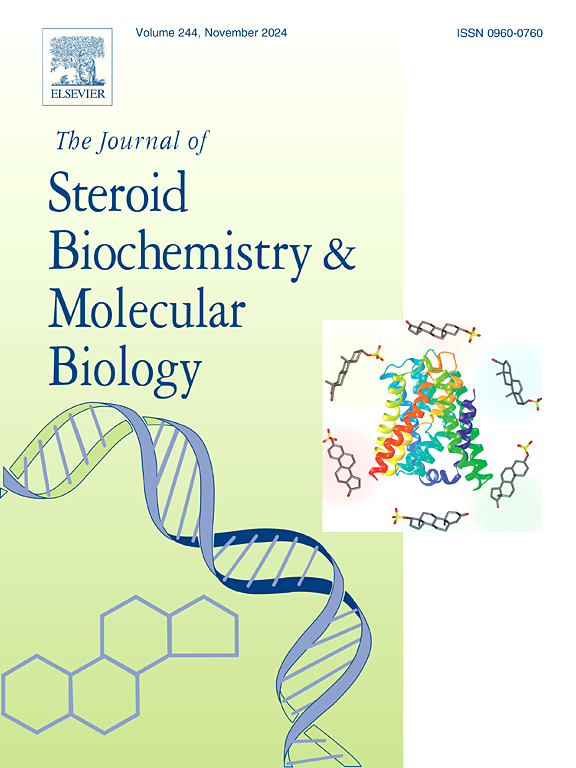Production of 11-ketotestosterone in childhood adrenal tumors with virilization or peripheral precocious puberty: Dominant expression of 11β-hydroxysteroid dehydrogenase type 2
IF 2.5
2区 生物学
Q3 BIOCHEMISTRY & MOLECULAR BIOLOGY
Journal of Steroid Biochemistry and Molecular Biology
Pub Date : 2025-04-01
DOI:10.1016/j.jsbmb.2025.106747
引用次数: 0
Abstract
11-Oxygenated androgens are important components of the androgen pool in humans. Among them, 11-ketotestosterone (11-KT), a potent 11-oxygenated androgen primarily produced in peripheral tissues outside the adrenal glands, has garnered research interest for its crucial role in several diseases associated with androgen excess. This study aimed to investigate the biosynthesis of 11-oxygenated androgens, particularly 11-KT, in childhood adrenocortical tumors (ACTs) presenting with symptoms of androgen excess. This retrospective study included three patients, aged 6 months, 2 years, and 12 years, presenting with symptoms of androgen excess due to childhood ACTs. Multiple androgen metabolites were simultaneously measured using pre- or postoperative serum samples, tumors, and tumor-attached adrenal glands obtained from patients using liquid chromatography-tandem mass spectrometry. The expression of genes involved in androgen synthesis was analyzed using DNA microarray analysis. Serum androgen levels were elevated prior to tumor removal and decreased to within or near reference ranges after tumor removal. Notably, serum 11-KT levels were markedly elevated compared to reference ranges, similar to testosterone (T), and 11-KT was abundant within the tumor tissues. Unique gene expression patterns were observed across the three cases of childhood ACTs, including marked HSD11B2, attenuated HSD11B1, and elevated HSD17B3 expression levels, which are involved in 11-KT biosynthesis. This study confirms the direct production of 11-KT in childhood ACTs; gene expression patterns observed in these cases favored 11-KT biosynthesis, providing insight into their potential role in androgen excess.
伴有男性化或外周性性早熟的儿童肾上腺肿瘤中11-酮睾酮的产生:11β-羟基类固醇脱氢酶2型的显性表达
氧合雄激素是人类雄激素库的重要组成部分。其中,11-酮睾酮(11-KT)是一种主要产生于肾上腺外周组织的强效11-氧合雄激素,因其在几种与雄激素过量相关的疾病中起关键作用而引起了研究兴趣。本研究旨在探讨以雄激素过量为症状的儿童肾上腺皮质肿瘤(act)中11-氧合雄激素(尤其是11-KT)的生物合成。本回顾性研究包括3例患者,年龄分别为6个月、2岁和12岁,表现为儿童期ACTs导致的雄激素过量症状。采用液相色谱-串联质谱法同时测定患者术前或术后血清样本、肿瘤和肿瘤附着肾上腺的多种雄激素代谢物。利用DNA芯片分析雄激素合成相关基因的表达。肿瘤切除前血清雄激素水平升高,肿瘤切除后下降到参考范围内或接近参考范围。值得注意的是,与参考范围相比,血清11-KT水平明显升高,与睾酮(T)相似,肿瘤组织中11-KT含量丰富。在3例儿童ACTs中观察到独特的基因表达模式,包括参与11-KT生物合成的HSD11B2标记,HSD11B1减弱和HSD17B3表达水平升高。这项研究证实了在儿童ACTs中直接产生11-KT;在这些病例中观察到的基因表达模式倾向于11-KT生物合成,从而深入了解它们在雄激素过量中的潜在作用。
本文章由计算机程序翻译,如有差异,请以英文原文为准。
求助全文
约1分钟内获得全文
求助全文
来源期刊
CiteScore
8.60
自引率
2.40%
发文量
113
审稿时长
46 days
期刊介绍:
The Journal of Steroid Biochemistry and Molecular Biology is devoted to new experimental and theoretical developments in areas related to steroids including vitamin D, lipids and their metabolomics. The Journal publishes a variety of contributions, including original articles, general and focused reviews, and rapid communications (brief articles of particular interest and clear novelty). Selected cutting-edge topics will be addressed in Special Issues managed by Guest Editors. Special Issues will contain both commissioned reviews and original research papers to provide comprehensive coverage of specific topics, and all submissions will undergo rigorous peer-review prior to publication.

 求助内容:
求助内容: 应助结果提醒方式:
应助结果提醒方式:


